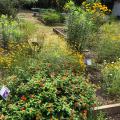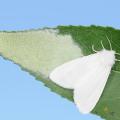Slugs
Slugs are non-insect pests that damage tender ornamental plants by chewing holes in leaves or flowers. They are especially damaging to hosta leaves and blooms of spring bulbs, but they attack a variety of other ornamental plants as well. Damage appears as long, narrow holes in leaves or ragged holes on edges of leaves and is often accompanied by shiny, dried slime trails. Slugs feed mostly at night or on cloudy days and hide under debris, mulch, or leaf litter during the day. Snails are similar to slugs, but have a shell into which they can retract their body. Most of the native species of snails we have here in the state feed on decaying plant material and rarely cause serious damage to live plants; slugs are much more damaging.
Control Slugs: Baits containing metaldehyde or iron phosphate are quite effective against slugs when used preventively. For example, to best protect hostas from early spring injury it is necessary to begin control in summer and fall of the previous year. Limiting conditions that are favorable to slugs, such as heavy accumulations of mulch or leaf litter, and refuge sites, such as boards or stones, will also help limit slug populations.
See Insect Pests of ornamental plants in the home landscape, page 14 and pages 39-41 for more information on slugs and snails.
Publications
News
A grant from Coast Electric will allow for a renovation of the Mississippi State University Crosby Arboretum’s pollinator garden. Pat Drackett, director of the arboretum, said the pollinator garden was established in 2001 as the Explorers’ Garden. It is a 3,000-square-foot space with a variety of native and other plants that helps teach visitors how to create havens for pollinators.
The 2020 Fall Flower & Garden Fest will be a virtual, educational event this year.
A tent for camping in the woods can be a good thing, but a tent filled with caterpillars in a pecan tree can be bad news for homeowners.




